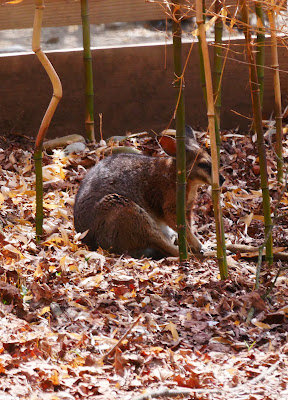Section V: Australian Fauna
Past the Farmyard area the path turns east and offers up a few iconic animals native to Australia. At one point they had a pair of Black Swans (Cygnus stratus); however with the advent of Avian Flu they have not been around for the past couple of visits. Though they remain on the Zoo's website listing of featured animals. What was there was a beautiful pair of Emu, a single Tammar Wallaby, and a pair of Red Kangaroos. With the latter two species, it's possible there were more of each; animals that had simply chosen to be in their interior areas.
Section VI: Habitat Madagascar
The first time I visited the Lehigh Valley Zoo, they had Ring-tailed Lemurs who all resided on an island in a large pond off of the deck area near the entrance. The island was notable for its three ginormous White Pines. The Lemurs had an enclosure, some things to climb on and jump between and then these amazing trees to climb. It was a little crude, but definitely gave the animals a safe outdoors place to call their own.
In 2020, they announced a project to construct a new habitat for Lemurs with state-of-the-art features. It was intimated that it would be possible to breed Lemurs in this new set-up. The price tag was somewhere around $250,000.00 if I recall correctly, which seemed like a real steal from my knowledge of the cost of other animal habitats of similar size that goes into the millions before the cap is removed from the pen. And coincidentally, the Brandywine Zoo was in the process of doing the same thing. The cost of theirs was $3,500,000.00. I had high hopes anyways. But alas, you do get what you pay for.
With the opening of the new Habitat Madagascar in 2023, the Ring-tail Lemurs were relocated and in their place a pair of Red Ruffed Lemurs, and a pair of Mongoose Lemurs were introduced. The building has two habitat spaces. One is completely interior with large windows that cannot be opened to allow fresh air to circulate. It's cluttered with faux limbs, climbing ropes and "toys". The two times I've visited the pair of Mongoose Lemurs have been huddled up high on platforms as far away from guests viewing as possible. Granted, I've only visited twice.
The other Habitat is suit with a smaller interior room and an open exterior space that is about the same size as the first habitat. It is also cluttered with faux tree limbs, platforms, climbing ropes and "toys". Both times I've visited the Red Ruffed Lemurs were hanging out in there. They seemed less stressed. The wonders of real grass beneath their feet and sunlight and fresh air.
In my opinion, they really need to upgrade the place. Both species should have large exterior spaces to hang out. First, I would attach a second larger exterior element to the first, interior only, habitat. Next, I would construct exterior only habitats in front of the building and connect them to the building's habitats with elevated habit-trail passageways. Configured to give either species the ability to go to either one as a way of introducing novelty
Section VII: African Hoofstock & Friends
Beyond the Lemurs are a series of four large habitats, two each on either side of the pathway. On the outside, the first habitat is home to Ostrich and a pair of Grant's Zebra, Glenda and Riley (both are female). As zebra subspecies go, Grant's are not that common, at least not at the zoo's I've managed to visit. They have strips that fall somewhere in between the wider stripped plains subspecies and the super tight narrow strips of the Grevy's Zebras.
On the same side a little further up is the Masai Giraffe habitat. The Lehigh Valley Zoo is home to a pair of males. In zoos with breeding programs there is usually only one male and a little collection of females. This leaves an excess of males that can be housed together in bachelor herds as long as there are no females around to instigate competition for mating. The two 8-year-olds are named Tatu and Joshua. Tatu is obviously taller and larger than Joshua making telling them apart relatively easy.
On the other side of the pathway the larger habitat is home to two species of Antelope. There are, by my count 9 Scimitar-Horned Oryx, and the zoo has seen 11 births in its herd since 2014. Once completely extinct in the wild, in recent years small herds have been re-introduced to areas in the Arabian peninsula where they once roamed wild. Officially, they are still considered Extinct in the Wild; however, their prognosis is looking up, and certainly the Lehigh Valley Zoo has every right to feel proud of their contribution.
The other Antelope is the Common Eland with a bull and two cows added to the zoo in between August 2022 (when Code, the male arrived) and May of 2023 (when sisters Moira and Alexis) came. All three were transferred from The Wilds in Ohio as an AZA Species Survival Program recommendation. The pairings literally bore fruit with the birth of a male calf (David) on January 6, 2025.
The final habitat is home to Kordofan Aoudads a wild mountain goat from central Asia.























No comments:
Post a Comment